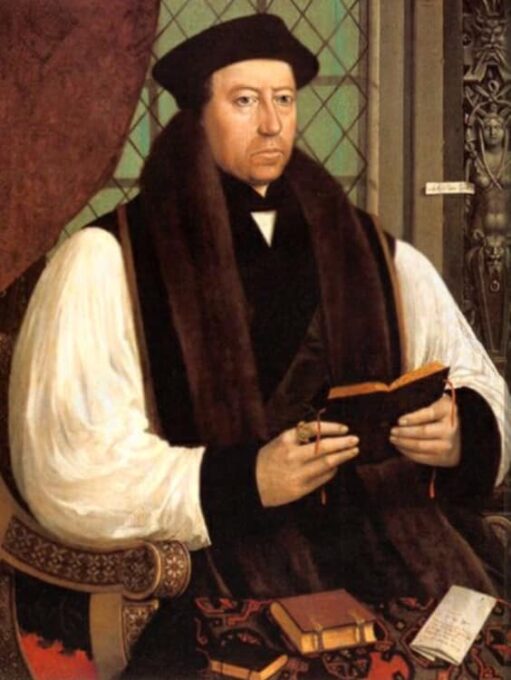Thomas Cranmer (July 2, 1489-March 21, 1556 ) was a leader of the English Reformationand Archbishop of Canterbury during the reigns of Henry VIII, Edward VI and, for a short time, Mary I.
With the assistance of several Continental reformers to whom he gave refuge, he changed doctrine in areas such as the Eucharist, clerical celibacy, the role of images in places of worship, and the veneration of saints. And because of this, after the accession of the Roman Catholic Mary I, Cranmer was put on trial for treason and heresy. Hear what Cranmer said with almost his last breath, in St. Mary’s Church, Oxford: “As for the sacrament, I believe, as I have taught in my book against the Bishop of Winchester, the which my book teaches so true a doctrine, that it shall stand at the last day before the judgment of God when the Papist’s doctrine contrary thereto shall be ashamed to show her face.”
Imprisoned for over two years and under pressure from Church authorities, he made several recantations and apparently reconciled himself with the Roman Catholic Church. However, on the day of his execution, he withdrew his recantations, to die a heretic to Roman Catholics and a martyr for the principles of the English Reformation.
He was martyred for denouncing the pope, saying, “As for the pope, I refuse him, as Christ’s enemy, and Antichrist with all his false doctrine.” He also spoke out against the ungodly, unBiblical teaching of purgatory, transubstantiation, salvation by works, and had temporarily, under great pressure from the authorities, signed a reprieve but recanted, thus saying “That unworthy hand! That unworthy hand!” while in the flames as they burned him alive at the stake for defending the Truth of Scripture over the ungodly, corrupt traditions of men. This he said as he held in the flames his right hand which had signed his apostasy.
An eyewitness account:
‘Make short! make short!’ and so they lit the wood. Then Cranmer lifted his left hand to heaven, And thrust his right into the bitter flame; And crying, in his deep voice, more than once, ‘This hand offended – this unworthy hand!’ So held it till it all was burned before The flame had reached his body; I stood near – he never uttered moan of pain: He never stirred or writhed, but, like a statue, Unmoving in the greatness of the flame, Gave up the ghost; and so passed martyr-like.”
Cranmer was a remarkable man— not only a theologian, but also a liturgical scholar, a writer, and the chief pastor of a national church. In trying to guide the Church of England from Catholicism to Protestantism, his main concerns were pastoral: he wanted to reform corporate worship and make it more meaningful for the layperson.
He was executed in 1556, during the brief but violent reign of Henry’s Catholic daughter Mary (ever after known in Protestant lore as “Bloody Mary”). Had he been allowed to live three more years, he would have been vindicated by Elizabeth I, whose reign began in 1559.
Strype calls Bradford, Cranmer, Ridley, and Latimer — the “four prime pillars” of the Reformed Church of England.
